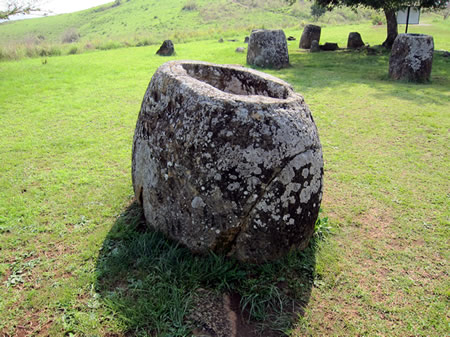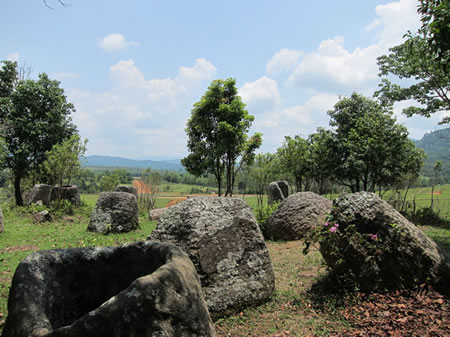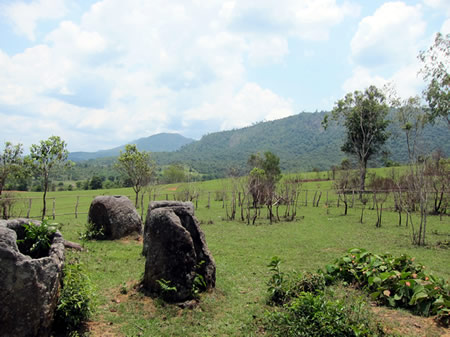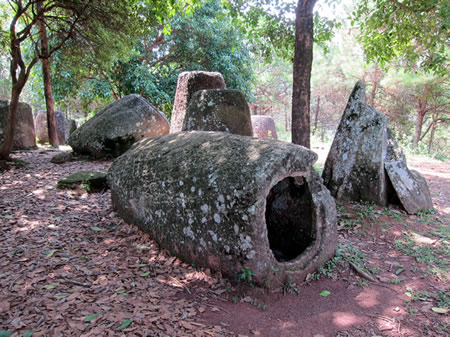Plain of Jars
The Plain of Jars is a megalithic archaeological landscape in Laos. It consists of thousands of stone jars scattered around the upland valleys and the lower foothills of the central plain of the Xiangkhoang Plateau. The jars are mostly arranged in clusters ranging in number from one to several hundred.
The Xieng Khouang Plateau is located at the northern end of the Annamese Cordillera, the principal mountain range of Indochina. French researcher Madeleine Colani concluded in 1930 that the jars were associated with prehistoric burial practices. Excavation by Lao and Japanese archaeologists in the intervening years has supported this interpretation with the discovery of human remains, burial goods and ceramics around the jars. The Plain of Jars is dated to the Iron Age (500 BC to AD 500) and is one of the most important prehistoric sites in Southeast Asia.
The Jar Sites
 More than 90 jar sites have been identified within Xiangkhouang Province. Each site has from one to 400 stone jars. The jars vary in height and diameter between 1m and 3m and are all hewn from rock. Their shape is cylindrical with the bottom always wider than the top. The stone jars are undecorated, with the exception of a single jar at Site 1. This jar has a human "frogman" bas-relief carved on the exterior. Parallels between the "frogman" and the rock painting at Huashan in Guangxi, China have been drawn. The Chinese paintings, which depict large full-frontal images of humans with arms raised and knees bent, are dated to 500 BC–200 AD.
More than 90 jar sites have been identified within Xiangkhouang Province. Each site has from one to 400 stone jars. The jars vary in height and diameter between 1m and 3m and are all hewn from rock. Their shape is cylindrical with the bottom always wider than the top. The stone jars are undecorated, with the exception of a single jar at Site 1. This jar has a human "frogman" bas-relief carved on the exterior. Parallels between the "frogman" and the rock painting at Huashan in Guangxi, China have been drawn. The Chinese paintings, which depict large full-frontal images of humans with arms raised and knees bent, are dated to 500 BC–200 AD.
Since most of the jars have lip rims, it is thought that the jars originally supported lids, although few stone lids have been recorded; this may suggest that the bulk of lids were fashioned from perishable materials. Stone lids with animal carvings have been found at few sites such as Ban Phakeo (Site 52). The bas-relief carvings are thought to depict monkeys, tigers and frogs. No in situ lid has ever been found.
Stone discs have also been found. The discs, which differ from the lids, have at least one flat side and are grave markers which were placed on the surface to cover or mark a burial pit. These grave markers appear more infrequently than jars, but are found in close proximity. Similar are stone grave markers; these stones are unworked, but have been placed intentionally to mark a grave. To the north of Xieng Khouang an extensive network of intentionally placed largely unworked stones marking elaborate burial pits and chambers are known as "standing stones of Huaphan". These have been dated to the Bronze Age.
The jars lie in clusters on the lower footslopes and mountain ridges of the hills surrounding the central plateau and upland valleys. Several quarry sites have been recorded, usually close to the jar sites. Five rock types have been identified: sandstone, granite, conglomerate, limestone and breccia.
The majority of the jars are sandstone. It is assumed that Plain of Jars' people used iron chisels to manufacture the jars, although no conclusive evidence for this exists. Regional differences in jar shape have been noted. While the differences in most cases can be attributed to choice and manipulation of rock source, some differences in form (such as variations in the placement of jar apertures) appear to be unique to specific sites.
 A cave located at Site 1 is a natural limestone formation with an opening to the northwest and two man-made holes at the top. These holes are thought to be chimneys for a crematorium. French geologist and amateur archaeologist Madeleine Colani excavated inside the cave in the early 1930s and found material to support a crematorium theory. Colani also recorded and excavated at 12 Plain of Jars sites and published two volumes with her findings in 1935. Colani concluded that the Plain of Jars was an Iron Age burial site. Inside the jars she found, embedded in black organic soil, coloured glass beads, burnt teeth and bone fragments, sometimes from more than one individual. Around the stone jars, she found human bones, pottery fragments, iron and bronze objects, glass and stone beads, ceramic weights and charcoal. The bone and teeth inside the jars show signs of cremation, while the burials surrounding the jars yield unburnt secondary burial bones.
A cave located at Site 1 is a natural limestone formation with an opening to the northwest and two man-made holes at the top. These holes are thought to be chimneys for a crematorium. French geologist and amateur archaeologist Madeleine Colani excavated inside the cave in the early 1930s and found material to support a crematorium theory. Colani also recorded and excavated at 12 Plain of Jars sites and published two volumes with her findings in 1935. Colani concluded that the Plain of Jars was an Iron Age burial site. Inside the jars she found, embedded in black organic soil, coloured glass beads, burnt teeth and bone fragments, sometimes from more than one individual. Around the stone jars, she found human bones, pottery fragments, iron and bronze objects, glass and stone beads, ceramic weights and charcoal. The bone and teeth inside the jars show signs of cremation, while the burials surrounding the jars yield unburnt secondary burial bones.
No further archaeological research was conducted until November 1994, when Professor Eiji Nitta of the Kagoshima University and Lao archaeologist Thongsa Sayavongkhamdy surveyed and mapped Site 1. Nitta claimed that the surrounding burial pits were contemporaneous to the jars, as they had been cut into the surface on which the jars had been placed. Nitta believed the jars were symbolic monument to mark the surrounding burials. He dated the Plain of Jars to the late second or early first millennium B.C. based on the burial urn and associated grave goods. Sayavongkhamdy undertook surveys and excavations between 1994 and 1996, supported by the Australian National University. Sayavongkhamdy and Peter Bellwood interpreted the stone jars as a central person's primary or secondary burial, surrounded by secondary burials of family members. Archaeological data collected during bomb clearance operations supervised by UNESCO archaeologist Julie Van Den Bergh in 2004–2005 and again in 2007 provided similar archaeological results. Like Nitta, Van Den Bergh concluded that the jars and surrounding burials were contemporaneous.
Variations in the practices of cremation inside jars and secondary burial outside jars, as noted by Colani, have proven difficult to explain. The cremated remains seem to mainly belong to adolescents. While the bomb clearance operations did not involve emptying of jars and thus no additional evidence could be gathered, Van Den Bergh claimed that the stone jars initially may have been used to distil the dead bodies and that the cremated remains within the jars represent the most recent phase in Plain of Jars. The jars with smaller apertures may reflect the diminishing need to place an entire body inside.
The suggestion that the jars, in a similar fashion to traditional Southeast Asian Royal mortuary practices, functioned as 'distilling vessels', was put forward by R. Engelhardt and P. Rogers in 2001. In contemporary funerary practices followed by Thai, Cambodian and Laotian royalty, the corpse of the deceased is placed into an urn during the early stages of the funeral rites, at which time the soul of deceased is believed to be undergoing gradual transformation from the earthly to the spiritual world. The ritual decomposition is later followed by cremation and secondary burial.
Incidentally, the megalithic Dravidians of South India used giant burial urns called Mudhumakkal Thazhi (burial-pots-of-the-old-people) or EemaThazhi. These funerary urns were buried with the bodies of the deceased or soon-to-die in a sitting posture, along with their personal goods and ornaments. This practice was in vogue until 200 AD.
 The royal burials are located across watercourses from the habitation areas in a geographically high, prominent area. Among the Black Thai people who have been in the region at least since the 11th century, the upper classes are cremated in the belief that it will release their spirits to heaven, while commoners are buried, leaving their spirits to remain on Earth.
The royal burials are located across watercourses from the habitation areas in a geographically high, prominent area. Among the Black Thai people who have been in the region at least since the 11th century, the upper classes are cremated in the belief that it will release their spirits to heaven, while commoners are buried, leaving their spirits to remain on Earth.
Colani connected the location of the jars sites to ancient trade routes, in particular with the salt trade. She assumed that salt was a commodity sought after by the Plain of Jars people, which brought traders to the Xieng Khouang Plateau. The Xieng Khouang area is rich in metallic minerals, mainly due to granite intrusions and associated hydrothermal activity.
Two principal iron ore deposits exist in Laos, both in Xieng Khouang. The presence and locations of the numerous jar sites in Xieng Khouang may relate to trading and mining activities. History has shown that Xieng Khouang, at the northern end of the Annamite Range, provides relative easy passage from the north and east to the south and west.
Within the geographic setting of Xieng Khouang, the jar sites may reflect a network of intercultural villages, whereby the locations of the jars are associated with long-distance overland routes which connect the Mekong basin and the Gulf of Tonkin System. The jar sites show superficial regional differences, such as jar form, material, and the number of jars per site. But all share common setting characteristics such as burial practices, elevated locations, and commanding views over the surrounding area.
The most investigated and visited Jar site is located close to the town of Phonsavan, and is known as Site 1. Seven jar sites have now been cleared of unexploded bombs and are open to visitors. These are currently sites 1, 2 and 3, and Site 16 near the Old Capital Xieng Khouang; Site 23, near the big hot spring in Muang Kham; Site 25 in the largely unvisited Phou Kout District; and Site 52, the largest known jar site to date with 392 jars near a traditional Hmong village only accessible by foot.
Legends and Local History
Lao legends tell of a race of giants who inhabited the area and who were ruled by a king, named Khun Cheung, who fought a long and ultimately victorious battle against an enemy. He supposedly created the jars to brew and store huge amounts of lau hai ("lau" means "alcohol", "hai" means "jar"—So "lau hai" means rice beer or rice wine in the jars) to celebrate his victory. Another local story states that the jars were molded from natural materials including clay, sand, sugar, and animal products in a type of stone mix. This led the locals to believe the cave at Site 1 was actually a kiln, and that the jars were fired there and are not actually hewn from stone.
Another suggested explanation for the jars' use is to collect monsoon rainwater for caravan travelers along their journey at times when rain may have been seasonal and water was not readily available on the easiest foot paths. Rainwater would then be boiled, even if stagnant, to become potable again, a practice long understood in Eastern Eurasia. The trade caravans that camped around these jars could have placed beads inside them as offerings, accompanying prayers for rain. Or the beads might simply have been unassociated lost items.
Current Situation
 Between 1964 and 1973, the Plain of Jars was heavily bombed by the U.S. Air Force (see Secret War) operating against North Vietnamese and Pathet Lao communist forces. The U.S. Air Force dropped more bombs on Laos, primarily the Plain of Jars, than it dropped during the whole of World War II. This included 262 million anti-personnel cluster bombs. An estimated 80 million of these did not explode and remain a deadly threat to the population.
Between 1964 and 1973, the Plain of Jars was heavily bombed by the U.S. Air Force (see Secret War) operating against North Vietnamese and Pathet Lao communist forces. The U.S. Air Force dropped more bombs on Laos, primarily the Plain of Jars, than it dropped during the whole of World War II. This included 262 million anti-personnel cluster bombs. An estimated 80 million of these did not explode and remain a deadly threat to the population.
The large quantity of unexploded bombs in the area, especially cluster munitions, limits free movement. Evidence of the bombing raids can be seen in the form of broken or displaced jars and bomb craters. Sightseeing on the Plain of Jars can only be done safely on cleared and marked pathways.
The Mines Advisory Group, a non-governmental organization, in collaboration with UNESCO and funded by the New Zealand government (NZAID), cleared unexploded bombs from the three most visited sites from July 2004 until July 2005. A second phase of bomb clearance at the sites also funded by NZAID was undertaken in 2007; four more jar sites were made safe.
The Lao PDR government and NZAID built a visitors centre that was opened on 13 August 2013 at the Plain of Jars Site 1. It is at the bottom of a hill 200m before a car park. The centre provides English language information panels on the history of the Plain of Jars culture, as well as its modern history during the 1964–1975 conflict.
The Lao PDR government is considering applying for status as a UNESCO World Heritage site for the Plain of Jars. The Lao-UNESCO Program for "Safeguarding the Plain of Jars" has been an ongoing effort by UNESCO and the Lao government to document and rehabilitate the Plain of Jars. Clearing the remaining bomb hazards must be done before the sites can be further studied and developed for tourism. One of the main objectives is community-based involvement in the management and conservation of the jar sites, which has been largely successful. However, tourism at the most visited sites has resulted in damage to some of the jars.
Gallery
Megalithic Builders is an index of ancient sites from around the world that contain stone megaliths or interlocking stones. Genus Dental Sacramento

